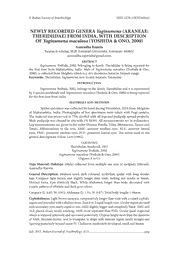
Newly Recorded Genera Yaginumena (Aranae: Theridiidae) from India, With Description of Yaginumena maculosa (Yoshida & Ono, 2000). PDF
Preview Newly Recorded Genera Yaginumena (Aranae: Theridiidae) from India, With Description of Yaginumena maculosa (Yoshida & Ono, 2000).
© Indian Society of Arachnology ISSN 2278-1587(Online) NEWLY RECORDED GENERA Yaginumena (ARANEAE: THERIDIIDAE) FROM INDIA, WITH DESCRIPTION OF Yaginumena maculosa (YOSHIDA & ONO, 2000) Anuradha Rajoria Research scholar, SGB Amravati University, Amravati-444602 [email protected] ABSTRACT Yaginumena Yoshida, 2002, belonging to family Theridiidae is being reported for the first time from Maharashtra, India. Male of Yaginumena maculosa (Yoshida & Ono, 2000), is collected from Melghats which is a dry deciduous forest in Satpuda range. Keywords: Theridiidae, Yaginumena, new record, Satpuda, Taxonomy INTRODUCTION Yaginumena Yoshida, 2002, belongs to the family Theridiidae and it is represented by 3 species worldwide and Yaginumena maculosa (Yoshida & Ono, 2000) is being reported for the first time from India. MATERIALS AND METHODS Spider specimen was collected by hand during December, 2014 from Melghats of Maharashtra, India. Photographs of live specimens were taken with Fugi camera. The material was preserved in 75% alcohol with all legs and pedipalp spread properly. Male pedipalp was cleared in situ with 1% KOH. All measurements are in milimeters. Leg measurements are given in the order (Femur, Patella, Tibia, Metatarsus, Tarsus and Total). Abbreviations in the text: AME- anterior median eyes, ALE- anterior lateral eyes, PME- posterior median eyes, PLE- posterior lateral eyes. The terms used in the genital descriptions follow Levi (1982). TAXONOMY Theridiidae, Sundevall, 1833 Yaginumena Yoshida, 2002 Yaginumena maculosa (Yoshida & Ono, 2000) (Figures A to G) Type Material: Holotype (Male) collected from multiple use area of melghats (Harisal), Anuradha Rajoria. General Description: Medium sized, dark coloured, ecribellate spider with long slender legs. Carapace light brown and slightly longer than wide, lacking any marks or bands. Distinct fovea. Eyes distinctly black. While Abdomen, longer than wide, decorated with cryptic pattern of offwhite and dark grey colour. Carapace (L: 0.83; W: 0.81); Abdomen (L: 1.01; W: 0.87); Total body length: 1.94mm. Cephalothorax: Light brown carapace, comparatively longer than wide with a raised cephalic region and provided with a distinct fovea. Eyes 8 in 2 equal length rows. Ocular region elevated with secondary eyes nearly equal in size. AME slightly bigger and completely black. AME and ALE placed closer, nearly touching. AME more separated than PME. Ocular quad. trapezoid which is widened anteriorly and narrowed posteriorly. Clypeus height more than the diameter of AME. Sternum brown, oval to triangular in shape with anterior region nearly straight and tapering posteriorly beyond coxae IV. Chelicerae moderately developed, small and brown. July 2015, Indian Journal of Arachnology, 4(1)........................................................................056 Description of new species,Yaginumena maculosa.........................................Anuradha Rajoria A D B E C F Figures A-F: Yaginumena maculosa; A: Habitus sketch of cephalothorax & abdomen B: Side view; C: Complete leg; D: Front view showing raised eyes; E: Dentate tarsal claws (Image: 8kv, X1900, 10µm); F: Palpal view (Image: 8kv, X200, 50µm); July 2015, Indian Journal of Arachnology, 4(1)........................................................................057 Description of new species,Yaginumena maculosa.........................................Anuradha Rajoria Figure. G: Yaginumena maculosa; Spinnerets (Image: 8kv, X400, 50µm). Cheliceral furrow without teeth. Maxillae brown elongated and provided with depleted scopular hairs but with prominent serrula. Labium nearly rectangular and longer than wide. Legs long, 3 clawed, light brown, clothed with spines. prominent trichobothria on femur and tibial segments. Leg measurements: I (0.74, 0.51, 0.85, 0.48, 0.30: 2.88); II (0.56, 0.48, 0.36, 0.30, 0.25: 1.95); III (0.58, 0.29, 0.38, 0.43, 0.38: 2.06); IV (0.53, 0.30, 0.63, 0.36, 0.30: 2.12). Leg formula - 1423. Palp well developed and the cymbium is comparatively bigger, almost equal to the length of the palpal segment. Recepticulum seminis quite prominently visible, comparatively wider and coiled within the bulbus and forming indistinct curves. Subtegulum large and embolus quite small and thin. Theridioid tegular apophysis is very prominent and sclerotised. Abdomen: Abdomen slightly elongated to globose with cryptic dorsal pattern due to presence of flecks of off-white and grey colors. Dorsum otherwise lacking any modification and clothed with fine hairs. Ventrum, comparatively lighter in shade and furnished with scattered hairs. Spinnerets, well developed, all are nearly equal in size. Colulus indistinct. DISCUSSION Yaginumena maculosa (Yoshida & Ono, 2000), transferred here from Dipoena Thorell, 1869 and Dipoena castrata Bösenberg & Strand, 1906 taken as the type species for Y. castrata (Bösenberg & Strand, 1906). This particular species shows a distribution range from Azerbaijan, Abkhazia, China, Japan and now India. REFERENCES Kovblyuk, M. M., Y. M. Marusik and M. M. Omelko. 2012. A survey of transcaucasian Dipoena sensu lato (Aranei: Theridiidae) with a description of new species. Arthropoda Selecta, 21: 247-254. Marusik, Y. M., E. F. Guseinov, S. Koponen, and H. Yoshida. 2005. A new case of Caucasus-Far East disjunctive range in spiders (Araneae). Acta Arachnologica, Tokyo 53: 125-129. Yoshida, H. and H. Ono. 2000. Spiders of the genus Dipoena (Araneae, Theridiidae) from Japan. Bulletin of the National Museum of Nature and Science Tokyo, (A) 26: 125-158. Yoshida, H. 2003. The spider family Theridiidae (Arachnida: Araneae) from Japan. Arachnological Society of Japan, 224 pp. July 2015, Indian Journal of Arachnology, 4(1)........................................................................058
